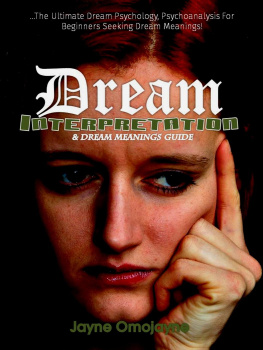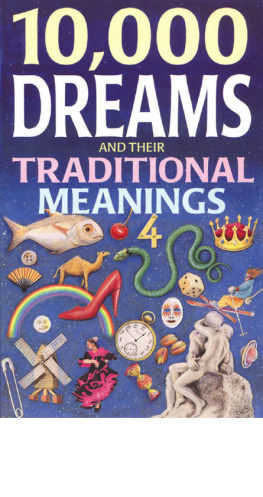
A Mbius Snake/Rope. Painting by R. Williams
Wendy Doniger OFlaherty
DREAMS, ILLUSION, and other REALITIES
The University of Chicago Press
Chicago and London
THE UNIVERSITY OF CHICAGO PRESS, CHICAGO 60637
THE UNIVERSITY OF CHICAGO PRESS, LTD., LONDON
1984 by the University of Chicago
All rights reserved. Published 1984
Paperback edition 1986
Printed in the United States of America
05 04 03 02 01 00 99 98 97 96 5 6 7 8 9
ISBN-10: 0-226-61855-2
ISBN-13: 978-0-226-61855-5 (pbk.)
ISBN: 978-0-226-30809-8 (e-book)
LIBRARY OF CONGRESS CATALOGING IN PUBLICATION DATA
OFlaherty, Wendy Doniger.
Dreams, illusion, and other realities.
Includes tales from the Yogavsiha.
Bibliography: p.
Includes indexes.
1. Dreams. 2. Mythology, Indic. 3. Yogavsiharmyaa. 4. YogaEarly works to 1800. I. Yogavsiharmyaa. II. Title.
BF1078.0'45 1984 111 83-17944
 The paper used in this publication meets the minimum requirements of the American National Standard for Information SciencesPermanence of Paper for Printed Library Materials, ANSI Z39.481984.
The paper used in this publication meets the minimum requirements of the American National Standard for Information SciencesPermanence of Paper for Printed Library Materials, ANSI Z39.481984.
for David Grene
Illustrations
FRONTISPIECE
.
PLATES
FIGURES
Guide to Pronunciation and Terminology
Sanskrit vowels are pronounced very much like Italian vowels, with the exception of the short a, which is pronounced like the u in the English word but; long is pronounced like the a in father.
As for the consonants, a reasonable approximation will be obtained by pronouncing c as in church, j as in jungle, as in shun, s as in sun, and as something halfway between the other two ss. The aspirated consonants should be pronounced distinctly: bh as in cab horse, dh as in madhouse, gh as in doghouse, ph as in top hat, and th as in goatherd. is a vowel, pronounced midway between ri as in rivet and er as in mother.
I have tried to be consistent in substituting English words for the various Sanskrit terms for different kinds of mental error. Delusion translates moha; illusion is my; and mistake is bhrama or vibhrama or bhrnti. I have called pratibhsa reflected image, prama proof of knowledge or way of knowing or authority, savid conscious perception, pratyaka direct perception or first-hand experience or before ones own eyes, and vsan karmic memory trace. I have also tried to distinguish between the various castes of demons: Asuras (demons), Rkasas (ogres), Picas (ghouls or flesh-eating ogres), Vetlas (vampires), Pretas (ghosts), and Bhtas (ghosts or has-beens). I have not tried to distinguish between the various castes of Untouchables but have used the word Untouchable to translate several different Sanskrit terms for people beyond the Aryan paleCalas, Pulkasas (or Pukkasas, or Pukasas), vapacas (Dog-cookers), Bhtas (Spooks), and Kiras (hunters).
The translations are all my own unless otherwise attributed, but they are often summaries of long texts rather than complete translations; I have added nothing, but I have left a lot out. In condensations of European texts, as in translations from the Sanskrit, something of the flavor of the original is inevitably lost, but I hope that the structure and some of the meanings still come through.
Acknowledgments
The ideas in this book first began to take shape at a symposium, organized jointly by the journal Daedalus and Emory University, which met in Atlanta on October 2327, 1979; the papers read there were subsequently published as the Summer, 1980, issue of Daedalus. I am grateful not only to Stephen Graubard (editor of Daedalus) and James Laney (president of Emory) but to all of the other contributors to that symposium (particularly to Judith Shklar, Karl H. Pribram, James Boon, Stanley Cavell, Stephen Jay Gould, and Leon Cooper) for generating such fertile excitement in me and, indeed, in all who were present. The continued research for the book was made possible by a grant from the National Endowment for the Humanities, for the summer of 1980, and the John Simon Guggenheim Memorial Foundation, for 198081. A preliminary report on my researches formed the substance of the Sir George Birdwood Memorial Lecture of the Royal Society of Arts, delivered in London on May 20, 1980; the Royal Society of Arts also generously contributed to my expenses in obtaining the plates to illustrate that essay (which was published, under the title Illusion and Reality in the Yogavsiha, in the Journal of the Royal Society of Arts, January 1981: 10423) and to illustrate this book. Preliminary versions of scattered parts of the book have been published as articles in Daedalus (Inside and Outside the Mouth of God, Spring, 1980, pp. 93125, and The Dream Narrative and the Indian Doctrine of Illusion, Summer, 1982, pp. 93113); in Quadrant: The Journal of the C. G. Jung Foundation for Analytical Psychology (The Scientific Proof of Mythical Experience, Spring, 1981, pp. 4665); in Parabola (Hard and Soft Reality: The Indian Myth of the Shared Dream, Spring, 1982, pp. 5565); and, in German, as Der wissenschaftliche Beweis mythischer Erfahrung, pp. 43056 of Der Wissenschaftler und das Irrational, edited by Hans Peter Duerr (Frankfurt: Syndikat, 1982).
I am grateful to the librarians of the Chester Beatty Library in Dublin for the great trouble they took in enabling me to use their manuscript of the Yogavsiha on several occasions and for allowing me to reproduce several illustrations from it in this book. It was also most helpful to me to be able to present parts of the work in progress in the form of lectures, first at the American Museum of Natural History in New York, under the joint sponsorship of the C. G. Jung Foundation and the Museum, on March 22, 1981; then as the Foerster Lecture on the Immortality of the Soul, at the University of California at Berkeley, on March 9, 1982; then as the Mead-Swing Lectures at Oberlin College, March 2225, 1982; as the Otis Lectures at Wheaton College, October 2527, 1982; as the invited lecture at the South Asian Conference of the University of Wisconsin at Madison, on November 5, 1982; at a panel of the American Academy of Religion meeting in New York on December 21, 1982, organized by Jack Hawley and chaired by Edward C. Dimock; as the Snuggs Lectures at the University of Tulsa, March 1416, 1983; and, finally, as a course of lectures at the University of Chicago in the spring quarter, 1983.
The Joint Committee on South Asia of the American Council of Learned Societies and the Social Science Research Council awarded me a generous grant to pursue my studies of the relationship between mythology and science, of which I was able to spend only a small fraction (to take Thomas Kuhn and Leonard Nash to lunch). David White made the Index of Names and Terms.
I am grateful to Allen Thrasher, A. K. Ramanujan, Arnaldo Momigliano, James Boon, Sir Ernst Gombrich, Richard F. Gombrich, Sudhir Kakar, David Shulman, Susan Wadley, Gail Hinich, William K. Mahony, John Castelein, and Dorothy Stein for detailed and sensitive responses to the first draft; to Jacob Arlow and Martin Stein for discussions about the relationship between psychoanalysis and mythology; to Leonard Nash, Stephen Toulmin, Thomas Kuhn, David Szanton, and Clifford Geertz for discussions on religion and science; to Anthony C. Yu for help with the Chinese sources; to Ed Hamlin for help with the
Next page










 The paper used in this publication meets the minimum requirements of the American National Standard for Information SciencesPermanence of Paper for Printed Library Materials, ANSI Z39.481984.
The paper used in this publication meets the minimum requirements of the American National Standard for Information SciencesPermanence of Paper for Printed Library Materials, ANSI Z39.481984.